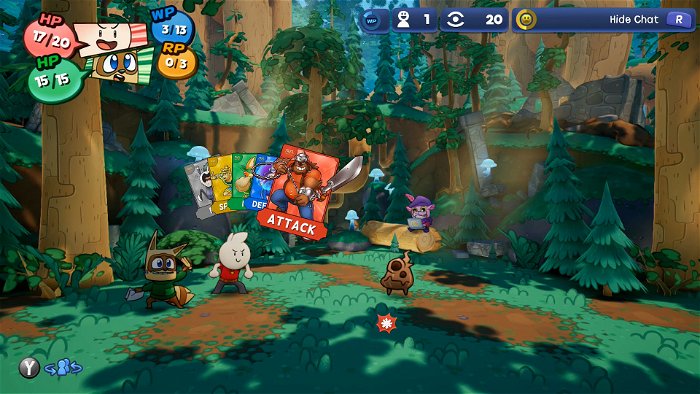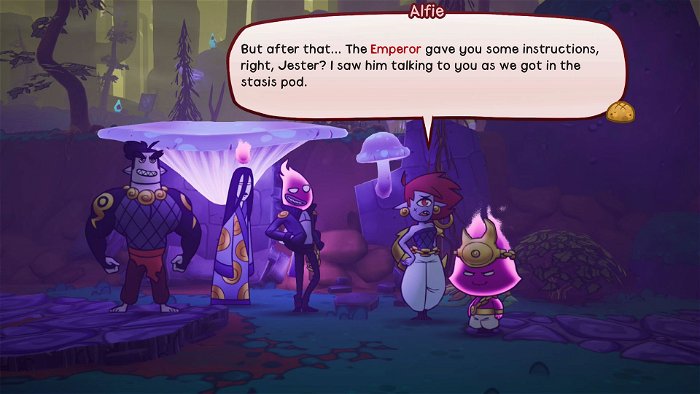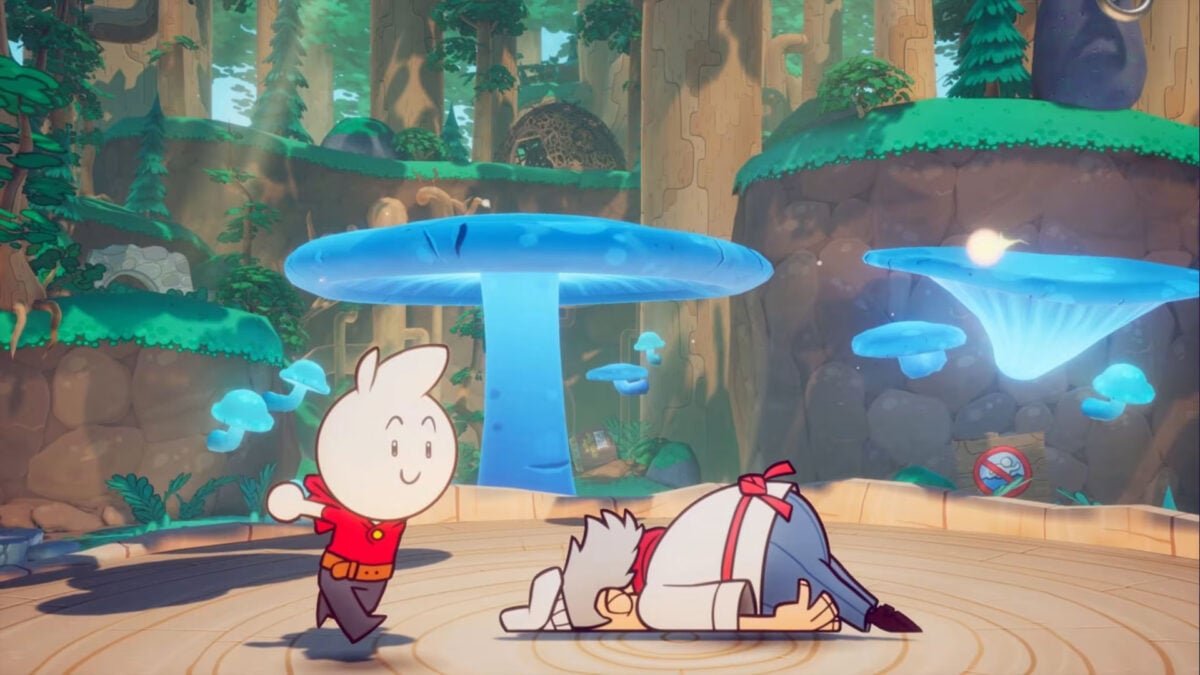I’ve had my eye on Born of Bread for a while now because, amid the “modern Paper Mario” discourse, I’m always interested in games that attempt the style of Paper Mario 64 or the most beloved Thousand Year Door. While the cynic in me hates the idea that people will point to games like this or Bug Fables as the “true” Paper Mario successors, the optimist in me sees no reason why games can’t emulate the style of such an enjoyable game.
I was ready to love Born of Bread, remembering all the things that made classic Paper Mario great and anxious to see a new game might reinvent them. I was expecting a rich, buttery croissant from an artisan baker, but instead got a lightly toasted piece of white bread with a smidge of margarine—Born of Bread does nothing to offend but does little to impress either.
The biggest problem with Born of Bread is a genuine lack of polish. I wanted to say that right up front because it is so thoroughly baked into the whole experience. Starting with the story—which opens with a character called Papa Baker who is the Kingdom’s Royal Baker, without any build-up or explanation, is just given a book that creates a boy made of dough, whom he names Loaf and who is also the main character of the game.

The whole scene moves so quickly and without any sense of resonance. There’s a certain amount of charm, like you can see where the developers wanted a sweet introduction to be, but the game is so eager to move past it that it loses any sense of meaning. Once Loaf is born, the game’s antagonists quickly show up—a gang of teenage fire demons led by their prince who is named Jester. Jester is looking for pieces of the Sunstone in order to restore his fallen kingdom to its former glory.
A bunch of whacky events ensue, all of which tie into the main goal of trying to get the Sunstone Shards before Jester does—in traditional Paper Mario fashion. It’s not a particularly bad story, but it’s not incredibly remarkable either. Moments just seem to come and go and leave no lasting impression. Much like Loaf’s introduction, even the way Partners come into the game is given almost no build-up, and eve once they join you there’s no clear explanation of their abilities—requiring players to go into the menu to see what they do. Even as I write this now, after just playing the game, I struggle to find any feelings that were stirred in me by any of the game’s proceedings. It’s just a little too safe.
Much like Paper Mario the game consists of exploring 3D levels and getting into turn-based battles. In a similar fashion, Loaf can mostly move around and whack certain items with his ladle—although certain environmental objects give him certain abilities—and he’ll need to rely on partners who join you on your quest to lend him their abilities to explore further. The Paper Mario inspiration is really worn on its sleeve, but much like the story, it lacks a lot of polish.
“Furthermore, while it borrows the core of Paper Mario’s combat—turn-based, timed hits, etc.—and both oversimplifies and needlessly complicates things.”
Battles are a fairly mundane affair that lacks some of the nuance of the early Paper Mario RPGs and some of the creativity of the modern ones. For starters, Loaf’s hitbox is incredibly weird, and activating “first hits” can be a bit of a gamble as his ladle never really hits where you think it’s going to, and can sometimes just trigger a fight normally. Alternatively, getting hit by an enemy first is incredibly punishing since—unlike Paper Mario where usually only the first enemy in a line will hit you—Born of Bread has every enemy in the fight hit Loaf if players are unlucky.
While it borrows the core of Paper Mario’s combat—turn-based, timed hits, etc.—it also oversimplifies and needlessly complicates things. This is most apparent in the QTEs for each attack, which lack the same kind of connective tissue that they had in Paper Mario—so Loaf’s ladle smash which is similar to Mario’s Hammer is just timing a button press, rather than pulling the stick back to simulate winding up.
In fact, a lot of the QTEs are just timing a button press, or holding a button, and some don’t really work on a technical level. Loaf has a special ability where he cooks himself to raise his defence, requiring players to hold down the A Button to fill a bar, and watching a separate bar to make sure he doesn’t burn. But the burn bar fills up so incredibly fast, and players have a limited time to complete the move, and while it’s still pretty easy to pull off, it never feels like it works quite right. Another of Loaf’s attacks requires players to hold a cursor in the center of a target, but as the cursor is pulled away aggressively, there’s almost no way to get it right.

On top of that, much like Paper Mario: The Thousand-Year Door, combat takes place in front of an audience—instead of being on stage however, it’s a live stream—but has no visual flair or simple communication to the player as to what’s affecting the view number. This lack of visual style also extends to attacks that come out so rapidly you have no time to take them in, and they lack any kind of weight or bombast. If they slowed it down a little, or maybe paused after an attack to really let you see it come to life, fights would be so much more dynamic.
Adding to the unnecessary complication, Loaf unlocks abilities through equipable items that need to be sorted in a Resident Evil 4–style inventory system, while Partners gain abilities through skill trees that can be upgraded by finding sleeping geckos hidden across the world. But players can only select one of three abilities on each level of the tree, which can actually leave them without a neutral ability that doesn’t constantly drain Will Points. And that’s before you get into the way there are three different attack types and nine different elemental types.
“But the worst break by far is how Born of Bread can hard-lock you fairly early one.”
But the biggest problem of all is that Born of Bread doesn’t really work on a technical level. There are so many little bugs and bad design choices that make the game annoying to play. To start, areas are far too open for no discernable reason. To compensate for this, areas are filled with an overabundance of pitfall traps that are easy to fall in with the game’s wonky platform physics. What made Paper Mario’s levels so solid was the way they felt open, but were still designed with a degree of linearity, encouraging exploration, but keeping players on the right path. Born of Bread actively punishes players for following their natural curiosity, but also blocks areas you’d think would be open, like small ledges or obstacles you could easily jump over with invisible walls.
However, these are a mild annoyance compared to the way the game is straight-up broken. The first instance of this is when you’re presented with the first of Loaf’s environmental abilities—walking into a hydraulic press to be pounded flat, allowing him to walk under small gaps. Firstly, playing into the game’s lack of polish, this is not presented with any kind of resonance or importance nor is it explained to you in any way, so players have no idea Loaf can also jump and hover a short distance while flat. Furthermore, walking into the press will sometimes just not trigger the ability requiring players to either reset the game or try leaving the area to refresh it in order to get it working.
But the worst break by far is how Born of Bread can hard-lock you fairly early one. I don’t know if it’s a problem with the Switch version, or if it’s just a problem with the game, but it happens pretty early on and bricks the whole game. Now I’m going to warn of MILD SPOILERS here, but it needs to be said to communicate the break. During a part where you’re made to control Jester, you’re tasked with exploring the castle to find clues to the whereabouts of the next Sunstone. As part of this, you need to destroy some boxes with his ability to conjure small fires—much like Loaf smashes things with his ladle.
However, for whatever reason, doing this can cause him to get locked in an animation frame and unable to move or do any other thing. He’s just locked in place and the game is over. And if you didn’t save before this happened, well then you’re going back to the last place you did because Born of Bread doesn’t auto-save. This actually happened to me after a boss fight where a moment controlling Jester—which really could’ve just been a cutscene—I pressed his attack button to see if he controlled like Loaf and it froze him in place and hard-locked again, forcing me to go back and fight the boss again.
I was willing to forgive the first break as a simple mistake in a moment that didn’t require much gameplay. I tried as hard as I could to give Born of Bread chances, using the attack as little as possible to avoid a break, but the fact that this can happen in a moment where you NEED to use the attack that can hard-lock the game destroyed any desire I might’ve had to continue playing. Say what you want about “modern” Paper Mario games. At least they work.

Visually, Born of Bread is a bit spotty. While it does have a colourful and interesting world, populated by charming, hand-drawn characters; it too suffers from that lack of polish. The aforementioned lack of visual flair during battles is a big part of it, the way the camera follows the character can cause objects to completely obstruct the screen, Partners frequently blink in and out of existence before attacks, and a completely unnecessary The Office reference has Micheal perpetually floating off the ground—maybe he’s doing parkour?
Although I will say, I do really like Born of Bread’s soundtrack. Each area has a fun, whimsical theme that adds a lot of fun to the adventure, and the battle theme is particularly good—changing and adding little bits of flair with each new area. However, polish where polish is needed: the game really could’ve done with a more exciting level-up theme—or a level-up theme of any kind.
I could go on and on, but I think by now you get the point. I really wanted to love Born of Bread and I really tried to give it a chance. But the more time I spent with it, it kept finding new ways to make me not want to play it. It’s got charm, and it certainly has heart, but its massive flaws acted as a foil to the smaller ones and only made them more annoying. Players jonesing for a “true” Paper Mario may find a lot to love with Born of Bread, but with its massive breakages and distinct lack of polish, I can’t really recommend it.





